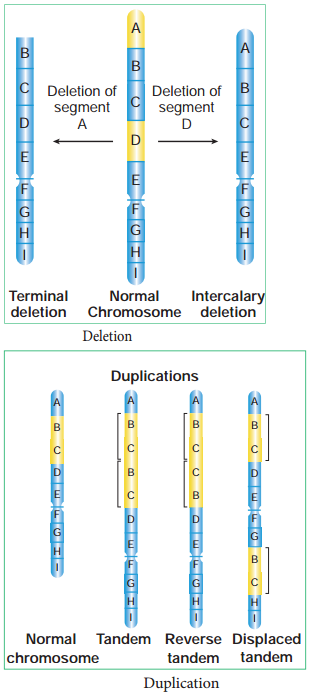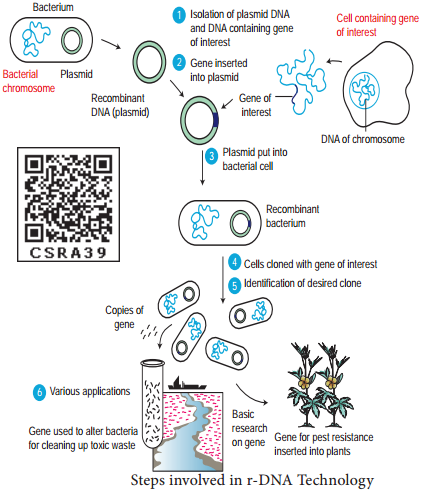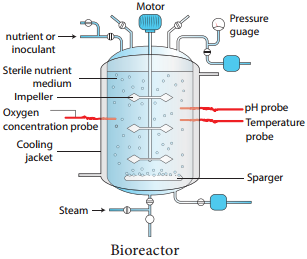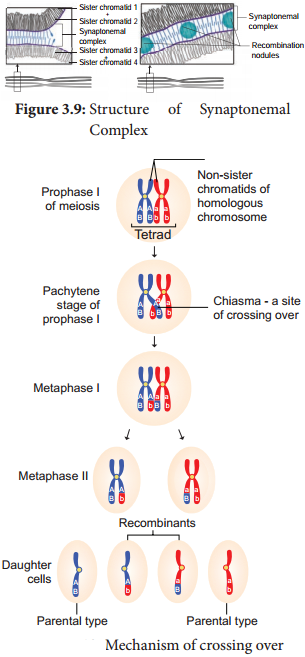Learninsta presents the core concepts of Biology with high-quality research papers and topical review articles.
Mutation – Types, Mutagenic Agents and Their Significance
Genetic variation among individuals provides the raw material for the ultimate source of evolutionary changes. Mutation and recombination are the two major processes responsible for genetic variation. A sudden change in the genetic material of an organisms is called mutation. The term mutation was introduced by Hugo de Vries (1901) while he has studying on the plant, evening primrose (Oenothera lamarkiana) and proposed ‘Mutation theory’.
There are two broad types of changes in genetic material. They are point mutation and chromosomal mutations. Mutational events that take place within individual genes are called gene mutations or point mutation, whereas the changes occur in structure and number of chromosomes is called chromosomal mutation.
Agents which are responsible for mutation are called mutagens, that increase the rate of mutation. Mutations can occur either spontaneously or induced. The production of mutants through exposure of mutagens is called mutagenesis, and the organism is said to be mutagenized.
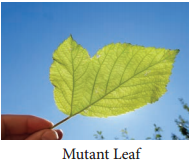
Types of mutation
Let us see the two general classes of gene mutation:
- Mutations affcting single base or base pair of DNA are called point mutation
- Mutations altering the number of copies of a small repeated nucleotide sequence within a gene
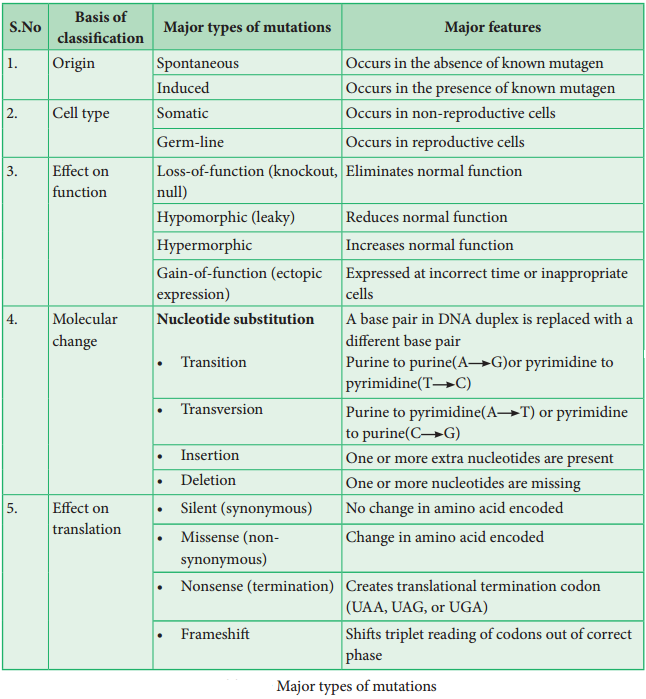
Point mutation
It refers to alterations of single base pairs of DNA or of a small number of adjacent base pairs.
Types of point mutations
Point mutation in DNA are categorised into two main types. They are base pair substitutions and base pair insertions or deletions. Base substitutions are mutations in which there is a change in the DNA such that one base pair is replaced by another (Figure: 3.17).
It can be divided into two subtypes: transitions and transversions. Addition or deletion mutations are actually additions or deletions of nucleotide pairs and also called base pair addition or deletions. Collectively, they are termed indel mutations (for insertion-deletion).
Substitution mutations or indel mutations affect translation. Based on these different types of mutations are given below. The mutation that changes one codon for an amino acid into another codon for that same amino acid are called Synonymous or silent mutations. The mutation where the codon for one amino acid is changed into a codon for another amino acid is called Missense or non-synonymous mutations.
The mutations where codon for one amino acid is changed into a termination or stop codon is called Nonsense mutation. Mutations that result in the addition or deletion of a single base pair of DNA that changes the reading frame for the translation process as a result of which there is complete loss of normal protein structure and function are called Frameshift mutations (Figure: 3.19).
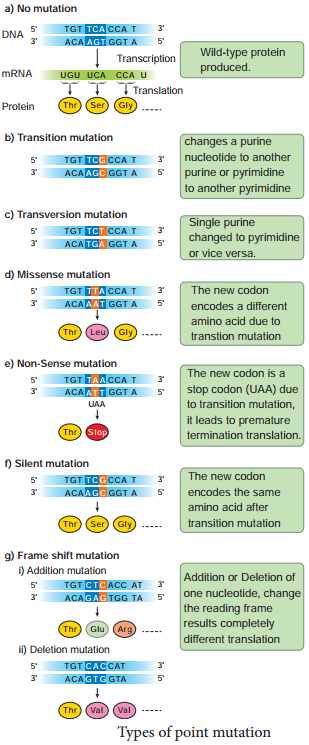
Mutagenic agents
The factors which cause genetic mutation are called mutagenic agents or mutagens. Mutagens are of two types, physical mutagen and chemical mutagen. Muller (1927) was the first to fid out physical mutagen in Drosophila.
Physical mutagens:
Scientists are using temperature and radiations such as X rays, gamma rays, alfa rays, beta rays, neutron, cosmic rays, radioactive isotopes, ultraviolet rays as physical mutagen to produce mutation in various plants and animals.
Temperature:
Increase in temperature increases the rate of mutation. While rise in temperature, breaks the hydrogen bonds between two DNA nucleotides which affects the process of replication and transcription.
Radiation:
The electromagnetic spectrum contains shorter and longer wave length rays than the visible spectrum. These are classified into ionizing and non-ionizing radiation. Ionizing radiation are short wave length and carry enough higher energy to ionize electrons from atom.
X rays, gamma rays, alfa rays, beta rays and cosmic rays which breaks the chromosomes (chromosomal mutation) and chromatids in irradiated cells. Non-ionizing radiation, UV rays have longer wavelengths and carry lower energy, so they have lower penetrating power than the ionizing radiations. It is used to treat unicellular microorganisms, spores, pollen grains which possess nuclei located near surface membrane.
Sharbati Sonora
Sharbati Sonora is a mutant variety of wheat, which is developed from Mexican variety (Sonora 64) by irradiating of gamma rays. It is the work of Dr. M.S.Swaminathan who is known as ‘Father of Indian green revolution’ and his team.
Castor Aruna
Castor Aruna is mutant variety of castor which is developed by treatment of seeds with thermal neutrons in order to induce very early maturity (120 days instead of 270 days as original variety).
Chemical mutagens:
Chemicals which induce mutation are called chemical mutagens. Some chemical mutagens are mustard gas, nitrous acid, ethyl and methyl methane sulphonate (EMS and MMS), ethyl urethane, magnous salt, formaldehyde, eosin and enthrosine. Example: Nitrous oxide alters the nitrogen bases of DNA and disturb the replication and transcription that leads to the formation of incomplete and defective polypeptide during translation.
Comutagens
The compounds which are not having own mutagenic properties but can enhance the effects of known mutagens are called comutagens. Example: Ascorbic acid increase the damage caused by hydrogen peroxide. Caffine increase the toxicity of methotrexate.
Chromosomal mutations
The genome can also be modified on a larger scale by altering the chromosome structure or by changing the number of chromosomes in a cell. These large-scale variations are termed as chromosomal mutations or chromosomal aberrations. Gene mutations are changes that take place within a gene, whereas chromosomal mutations are changes to a chromosome region consisting of many genes.
It can be detected by microscopic examination, genetic analysis, or both. In contrast, gene mutations are never detectable microscopically. Chromosomal mutations are divided into two groups: changes in chromosome number and changes in chromosome structure.
I. Changes in chromosome number
Each cell of living organisms possesses fixed number of chromosomes. It varies in different species. Even though some species of plants and animals are having identical number of chromosomes, they will not be similar in character. Hence the number of chromosomes will not differentiate the character of species from one another but the nature of hereditary material (gene) in
chromosome that determines the character of species.
Sometimes the chromosome number of somatic cells are changed due to addition or elimination of individual chromosome or basic set of chromosomes. This condition in known as numerical chromosomal aberration or ploidy. There are two types of ploidy.
- Ploidy involving individual chromosomes within a diploid set (Aneuploidy)
- Ploidy involving entire sets of chromosomes (Euploidy) (Figure 3.20)
1. Aneuploidy
It is a condition in which diploid number is altered either by addition or deletion of one or more chromosomes. Organisms
showing aneuploidy are known as aneuploids or heteroploids. Thy are of two types, Hyperploidy and Hypoploidy (Figure 3.21).
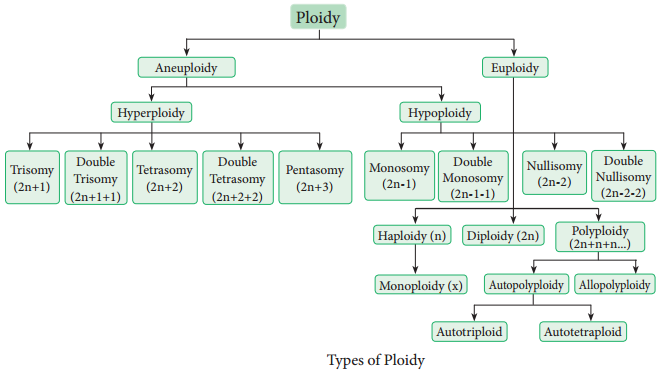
Hyperploidy
Addition of one or more chromosomes to diploid sets are called hyperploidy. Diploid set of chromosomes represented as Disomy. Hyperploidy can be divided into three types. They are as follows,
(a) Trisomy
Addition of single chromosome to diploid set is called Simple trisomy (2n+1). Trisomics were first reported by Blackeslee (1910) in Datura stramonium (Jimson weed). But later it was reported in Nicotiana, Pisum and Oenothera. Sometimes addition of two individual chromosome from diffrent chromosomal pairs to normal diploid sets are called Double trisomy (2n+1+1).
(b) Tetrasomy
Addition of a pair or two individual pairs of chromosomes to diploid set is called tetrasomy (2n+2) and Double tetrasomy (2n+2+2) respectively. All possible tetrasomics are available in Wheat.
(c) Pentasomy
Addition of three individual chromosome from different chromosomal pairs to normal diploid set are called pentasomy (2n+3).
2. Hypoploidy
Loss of one or more chromosome from the diploid set in the cell is called hypoploidy. It can be divided into two types. They are
(a) Monosomy
Loss of a single chromosome from the diploid set are called monosomy(2n-1). However loss of two individual or three individual chromosomes are called double monosomy (2n-1-1) and triple monosomy (2n-1-1-1) respectively. Double monosomics are observed in maize.
(b) Nullisomy
Loss of a pair of homologous chromosomes or two pairs of homologous chromosomes from the diploid set are called Nullisomy (2n-2) and double Nullisomy (2n-2-2) respectively. Selfig of monosomic plants produce nullisomics. They are usually lethal.
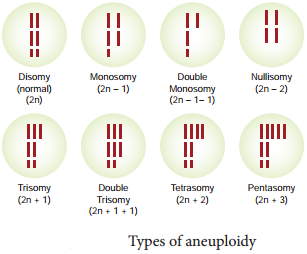
(ii) Euploidy
Euploidy is a condition where the organisms possess one or more basic sets of chromosomes. Euploidy is classifid as monoploidy, diploidy and polyploidy. The condition where an organism or somatic cell has two sets of chromosomes are called diploid (2n). Half the number of somatic chromosomes is referred as gametic chromosome number called haploid(n).
It should be noted that haploidy (n) is diffrent from a monoploidy (x). For example, the common wheat plant is a polyploidy
(hexaploidy) 2n = 6x = 72 chromosomes. Its haploid number (n) is 36, but its monoploidy (x) is 12. Therefore, the haploid and diploid condition came regularly one after another and the same number of chromosomes is maintained from generation to generation, but monoploidy condition occurs when an organism is under polyploidy condition. In a true diploid both the monoploid and haploid chromosome number are same. Thus a monoploid can be a haploid but all haploids cannot be a monoploid.
Polyploidy
Polyploidy is the condition where an organism possesses more than two basic sets of chromosomes. When there are three, four, fie or six basic sets of chromosomes, they are called triploidy (3x) tetraploidy (4x), pentaploidy (5x) and hexaploidy (6x) respectively.
Generally, polyploidy is very common in plants but rarer in animals. An increase in the number of chromosome sets has been an important factor in the origin of new plant species. But higher ploidy level leads to death. Polyploidy is of two types. They are autopolyploidy and allopolyploidy.
1. Autopolyploidy
The organism which possesses more than two haploid sets of chromosomes derived from within the same species is called autopolyploid. They are divided into two types. Autotriploids and autotetraploids.
Autotriploids have three set of its own genomes. They can be produced artifially by crossing between autotetraploid and diploid
species. They are highly sterile due to defective gamete formation. Example: The cultivated banana are usually triploids and are seedless having larger fruits than diploids.
Triploid sugar beets have higher sugar content than diploids and are resistant to moulds. Common doob grass (Cyanodon dactylon) is a natural autotriploid. Seedless watermelon, apple, sugar beet, tomato, banana are man made autotriploids. Autotetraploids have four copies of its own genome. They may be induced by doubling the chromosomes of a diploid species. Example: rye, grapes, alfalfa, groundnut, potato and coffee.
2. Allopolyploidy
An organism which possesses two or more basic sets of chromosomes derived from two different species is called allopolyploidy. It can be developed by interspecific crosses and fertility is restored by chromosome doubling with colchicine treatment. Allopolyploids are formed between closely related species only. (Figure 3.22)
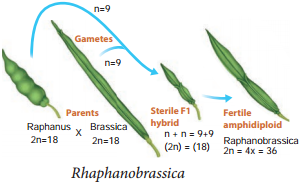
Karpechenko (1927) a Russian geneticist, crossed the radish (Raphanus sativus, 2n=18) and cabbage (Brassica oleracea, 2n=18) to produce F1 hybrid which was sterile. When he doubled the chromosome of F1 hybrid he got it fertile. He expected this plant to exhibit the root of radish and the leaves like cabbage, which would make the entire plant edible, but the case was vice versa, so he was greatly disappointed.
Example: 2 Triticale, the successful fist man made cereal. Depending on the ploidy level Triticale can be divided into three main groups.
(i) Tetraploidy:
Crosses between diploid wheat and rye.
(ii) Hexaploidy:
Crosses between tetraploid wheat Triticum durum (macaroni wheat) and rye
(iii) Octoploidy:
Crosses between hexaploid wheat T. aestivum (bread wheat) and rye Hexaploidy Triticale hybrid plants demonstrate characteristics of both macaroni wheat and rye.
For example, they combine the high-protein content of wheat with rye’s high content of the amino acid lysine, which is low in wheat. It can be explained by chart below (Figure: 3.23).
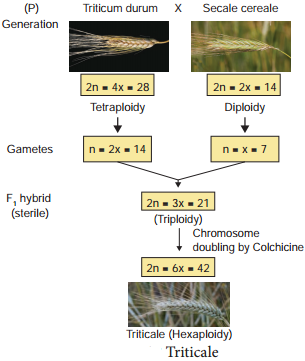
Signifiance of Ploidy
- Many polyploids are more vigorous and more adaptable than diploids.
- Many ornamental plants are autotetraploids and have larger flowers and longer flowering duration than diploids.
- Autopolyploids usually have higher in fresh weight due to more water content.
- Aneuploids are useful to determine the phenotypic effcts of loss or gain of different chromosomes.
- Many angiosperms are allopolyploids and they play a role in the evolution of plants.
II Structural changes in chromosome (Structural chromosomal aberration)
Structural variations caused by addition or deletion of a part of chromosome leading to rearrangement of genes is called structural chromosomal aberration. It occurs due to ionizing radiation or chemical compounds. On the basis of breaks and reunion in chromosomes, there are four types of aberrations. They are classified under two groups.
A. Changes in the number of the gene loci
- Deletion or Defiiency
- Duplication or Repeat
B. Changes in the arrangement of gene loci
1. Deletion or Defiiency
Loss of a portion of chromosome is called deletion. On the basis of location of breakage on chromosome, it is divided into terminal deletion and intercalary deletion. It occurs due to chemicals, drugs and radiations. It is observed in Drosophila and Maize. (Figure 3.24)
2. Duplication or Repeat
The process of arrangement of the same order of genes repeated more than once in the same chromosome is known as duplication. Due to duplication some genes are present in more than two copies. It was first reported in Drosophila by Bridges (1919) and other examples are Maize and Pea. It is three types.
4. Translocation
The transfer of a segment of chromosome to a non-homologous chromosome is called translocation. Translocation should not
be confused with crossing over, in which an exchange of genetic material between homologous chromosome takes place.
Translocation occurs as a result of interchange of chromosome segments in non-homologous chromosomes. There are three types
- Simple translocation
- Shif translocation
- Reciprocal translocation
